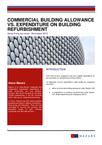Dec. 2012 - Commercial building allowance vs. Expenditure on building refurbishment
Deduction of renovation/refurbishment expenditure
For deduction of such expenditure under profits tax, taxpayers may claim:
- either commercial building allowance under Section 33A
- or expenditure on building refurbishment under Section 16F of the Inland Revenue Ordinance (“IRO”).
COMMERCIAL ALLOWANCE
Pursuant to Section 33A of the IRO, an annual allowance is granted for the year of assessment in which the building or structure is in use as a commercial building or structure and the relevant interest is not sold at the end of the basis period. The annual allowance is equal to 4% of the qualifying expenditure.
A commercial building or structure means any building or structure (or part), which is not an industrial building or structure, used by a taxpayer entitled to the relevant interest for the purposes of his trade, profession, or business.
Starting from the year of assessment 1998/99, balancing adjustment has to be made for a commercial building or structure that is sold or disposed of (Section 35 of the IRO).
EXPENDITURE ON BUILDING REFURBISHMENT
Pursuant to Section 16F of the IRO, a taxpayer who incurs capital expenditure on the renovation or refurbishment of a building or structure other than a domestic building or structure may claim a deduction of the refurbishment expenditure. Where a deduction for building refurbishment is allowed, the taxpayer is not entitled to any commercial building allowance on the same expenditure (Section 16F(3) of the IRO).
The deduction is allowed at 20% per year over five years starting from the year in which the expenditure was incurred.
If the building or structure for which a deduction is allowed under Section 16F is sold or disposed of before the five instalments are fully granted, the taxpayer will continue to claim the remaining instalment(s) as if the building or structure had not yet been sold or disposed of (Section 16F(2)). Any sale proceeds for the refurbishment expenditure, however, are not chargeable to tax.
Apart from the difference in annual deduction, tax treatment will vary in situations where the subject building or structure is sold or disposed of or the company ceased its business if the deduction claim is made under commercial building allowance or expenditure on building refurbishment.
For illustration purpose, a general comparison is shown in the table below* .
Commercial Building Allowance | Expenditure on Building Refurbishment | |
Annual deduction | 4% | 20% |
The building or structure is sold or disposed of | Balancing allowance or balancing charge will be applied under Section 35 of the IRO | Continue to claim annual deduction at 20% until the five instalments are fully granted under Section 16F(2) of the IRO |
The company ceased its business | Balancing allowance or balancing charge will be applied under Section 35 of the IRO | Unable to claim the remaining instalment(s), if any, even though the five instalments are not fully granted |
* The tax treatment is confirmed by the Inland Revenue Department at the annual meeting with the Hong Kong Institute of Certified Public Accountants held on 17 February 2012.

